Monthly Meetings
Our General Meeting is held the third Friday of every month at 7:30pm. in the LAPD West Valley Station Community Room, at 19020 Vanowen St, Reseda, CA 91335. (Click for a map or set your GPS to: 34°11’34.4″N 118°32’55.4″W.) Please park behind the library. Meetings are hybrid, with attendance also available via Zoom.
Future meetings
April 18, 2025
May 16, 2025
April 18, 2025 — Paul Hamilton, KE7UAE, on Mag Loop Antennas, From Theory to Workbench
Our speaker on Friday, Apr 18, was Paul Hamilton, KE7UAE, who talked about the theory and construction of magnetic loop antennas.
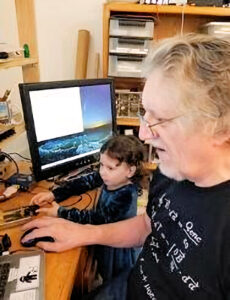
After earning his BS in electrical engineering at the University of Kentucky, Paul worked as an RF test engineer for McDonnell Douglas, in St. Louis, where he looked after the test benches for radios in military aircraft.
He then moved to the Pacific Northwest, working as a test engineer for Motorola and other cell phone manufacturers and for Intel doing signal integrity work on computer motherboards.
Paul’s entry into ham radio began when he was taking a class in the principles of RF circuit design at Portland (OR) State University, where he went on to get a Masters of Electrical Engineering. His academic advisor, Rick Campbell, KK7B, got him interested in the hobby, and Paul earned his Technician, General and Extra classes while taking the class.
Paul regards Rick, KK7B, and Wes Hayward, W7ZOI, as Elmers who were key to his success as a ham. (Campbell and Hayward, along with Bob Larkin, W7PUA, authored “Experimental Methods in RF Design,” published by the ARRL.)
Now, retired, Paul divides his time between ham radio, his XYL, and his kids and grandkids. The accompanying photo shows him with his granddaughter, Lily, who is beginning to learn the basics of using a Morse Code key. Active in CW, primarily using bug keys, he belongs to CWops, LICW, and SKCC, where he is working towards that group’s Centurian designation.
Paul became interested in building and using tuned magnetic loop antennas when he realized that his QTH in Tualatin, OR wasn’t suitable for either an antenna tower or, “with trees like twigs,” for an elevated wire antenna.
“I needed an antenna that could work well for DX that could not fall on my neighbor’s property and would not need radials.” The answer, he decided, was a mag loop. He has built several of these antennas, of increasing size and sophistication, and will share with us both the theory and practice he brought to their construction and use.
March 21, 2025 – Anthony Luscre, K8ZT, on FT8 and FT4 Digital Modes
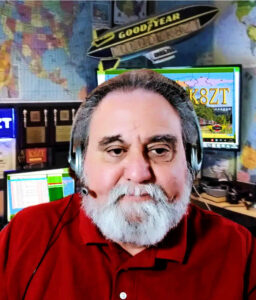
Few hams have not heard about FT8 and FT4 digital modes, but for many of us there is a significant gap between awareness of these modes and real knowledge of what they are, how to use them, and the advantages and challenges of doing so. Our March 21 speaker, Anthony Luscre, K8ZT, helped us close that gap.
A video of his talk is available on our YouTube channel.
Anthony talked about the origins of FT8 and FT4, developed by Princeton University Professor of Physics and Nobel Laureate Joe Taylor K1JT, and Dr. Steve Franke, K9AN, Professor Emeritus of Electrical Engineering at the University of Illinois Urbana-Champaign. (FT8 stands for “Franke-Taylor design, 8-Frequency Shift Keying modulation.”)
He explained how these digital modes encode and decode information, and why they are so effective at decoding weak signals even when used with low transmit power. That included an introduction to the JT65 and WSJT-X software that is key to FT8, and later to the faster, contesting-friendly FT4.
Anthony also debunked some common myths about these digital modes, such as that their use requires an internet connection, that no operator skill is required, and that only pricey, state-of-the-art radios can be used. (One rig he likes is a 5-Watt rig that retails for $69!)
First licensed in 1981, Anthony has always enjoyed operating QRP. He jokes that no one told him that as a Novice he shouldn’t start with a 2-Watt rig. He now enjoys contesting, DXing, rag chewing, working satellites, and operating HF,VHF, UHF, CW, phone and digital mode, with more than 117,000 QRP contacts in his logbook. His QRP DXCC total recently topped the 328 mark, and he has completed Worked All States on 11 bands from his home base in Stow, OH, a suburb of Akron.
Now retired, Anthony’s professional background includes 20 years as a medical technologist in clinical microbiology and 20 years as a computer consultant and computer technology director for 30 school districts. He also volunteers as a Trainman on the Cuyahoga Valley Scenic Railroad located in the Cuyahoga Valley National Park about 15 minutes from his home.
This was W6SD’s first in-person meeting since the outbreak of the pandemic in 2020. We met in the Community Room of the LAPD West Valley Station, 19020 Vanowen St., Reseda, at 7:30 p.m.
Past Meetings
February 21, 2025
Karin Thompson, KD4DXX: RT Systems and Programming Ham Radios
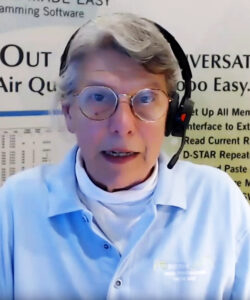
About 30 years ago, manufacturers of ham radios introduced models that could be programmed, for easier operation, and “cloned” to allow one ham to share the setup on his or her radio with another ham with the same rig. Rod Thompson, KU4HP, decided to try to see if he could get his radio to “talk” to a computer, to make the task of programming easier. Thompson, or RT, succeeded, and RT Systems was born.
As Karin Thompson, KD4DXX, Rod’s wife and co-owner of the company, explained at our meeting on Friday, Feb. 21, RT Systems, based in LaGrange, Georgia, now offers convenient, easy-to-use programming systems for more than four dozen brands of radios that include customized software and cables.
Licensed as a ham since 1990, Karin admits she now spends much more time helping her team get more functionality out of RT software and the radios it programs than getting on the air herself.
Among the topics she talked about is how RT extracts the information needed to program each specific radio, including the number and operation of its memory channels, the specific tones used for transmission and receiving, its memory channels and how they work, and what differences each radio may have that require unique settings to the programming software.
She also demonstrated the use of RT’s software and shared tips on how hams can copy and paste settings from one radio in their shack to another, even if they are from different manufacturers, how to create, edit and share external files, and much more.
January 17, 2025
Dan Lundwall, N7XDL: Making a Go-Kit That is Right For You
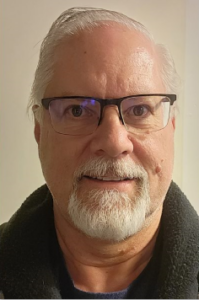
At our Jan. 17 meeting, at 7:30 p.m. on Zoom, Dan Lundwall, N7XDL, took us through the steps and ideas he recommends for creating a ham radio “go-kit” that fits your needs.
He said that starts with asking yourself, “What do I want my go-kit to accomplish?” Dan gave us many ideas on how to create the perfect kit that fits OUR needs and requirements. There are many pre-made go-kits available, but these may not meet your specific requirements.
In 1982 Dan Lundwall experienced two major earthquakes in Chile, one a 7.5 and the other a 7.4 on the Richter scale. A local ham radio operator helped him talk to his parents in Utah via a phone patch.
Dan put those memories aside until 2015, when he became an amateur radio operator. A year later he got his General Class license. He enjoys working both VHF/UHF and HF communications, and became interested in emergency communications when he joined the Salt Lake County ARES group.
He looked for a ham radio club in his home town of Murray, Utah, but there wasn’t one, so Dan founded the Murray Amateur Radio Club (https://murrayarc.org) and is now the president.
Dan serves as an Assistant Emergency Coordinator with Salt Lake County ARES, and is the State Emergency Communications Coordinator for his church. He says these activities are based on his awareness, thanks to his experiences in Chile, of what a major earthquake can do, and of the possibility t hat a major quake could hit Salt Lake County at any time.
December 8, 2024
Holiday Luncheon
Our Holiday Luncheon was held on Sunday, December 8, at Maggiano’s Little Italy restaurant, 6100 Topanga Canyon Blvd in Woodland Hills.
November 15, 2024
Greg Mihran, KJ6ER, on POTA Antennas
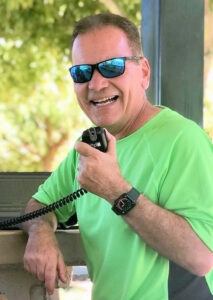
The W6SD monthly meeting on Friday, Nov. 15, featured a presentation by Greg Mihran, KJ6ER, on his two homebrew portable antennas he has used for POTA (Parks On The Air) activations over the past few years. His antennas are also ideal for emergency communications and as quick-deployment HOA antennas. Greg shares his antenna plans for free in PDF-format with the amateur community.
His PERformer (Portable, Efficient, Resonant) is a quarter wave vertical for 40M-6M. It uses a 17’ telescoping whip with two elevated tuned radials placed 90 degrees apart. This portable antenna has been in the field for more than five years and is used by over 1,000 portable antenna enthusiasts around the world for excellent continental communications.
The second is his Dominator half wave vertical for 20M-10M, using a 25’ telescoping whip and 49:1 transformer on a tripod with a single linked counterpoise. This portable antenna has been in the field for more than two years and is an excellent DX antenna for global communications.
He recently created a Dominator Vertical Beam with a parasitic director in front of the driven element for a portable 2-element beam.
Greg, an Extra-class ham based in Campbell, CA, has been operating HF/UHF/VHF since 1987. He has been especially active since retiring in 2022 after a 45-year career with a variety of large and start-up Silicon Valley tech companies.
September 20, 2024
Andy Pattantyus, KF0ARA, on Vacuum Tubes in Ham Radio History
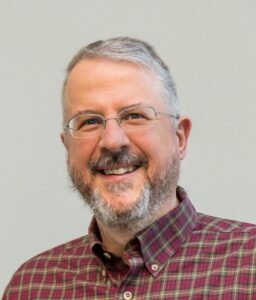
Just four years ago, well into a distinguished career in engineering, Imre “Andy” Pattantyus got his ham radio license as KF0ARA and began to delve into some of the less-frequented corners of our hobby. While most of us focus on new technologies that make ham radio easier and more enjoyable, such as computerized radios, DMR, and solid-state gadgetry, Andy became fascinated by the vacuum tubes that made the early days of amateur radio possible.
As he discussed with us at our monthly meeting Sept. 20, 2024, via Zoom, he explored how vacuum tubes work, and how they were used in radio circuits such as mixers, oscillators and amplifiers. This progressed into a deep study of electronic circuit theory.
Andy, based in Rapid City, SD, is president of the Black Hills Amateur Radio Club, W0BLK. Professionally he is a mechanical engineer and project manager with Turner Engineering Corp., with responsibilities that include railway safety assurance for passenger rolling stock and wayside equipment, as well as driverless vehicles. His work also includes managing electromagnetic interference and compliance.
Andy did his undergraduate studies in mechanical engineering at Virginia Tech, went on to earn a master’s there in that field, and received an MBA at Case Western.
August 16, 2024
David M. Pepper, Ph.D., WA6TWA, on T-Hunts
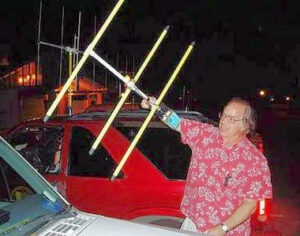
A popular fun and educational part of amateur radio is participating in a “transmitter hunt,” or T-hunt (sometimes known as a “Fox Hunt”), in which hams use handheld radios with highly directional antennas to locate low-power transmitters hidden in parks and other open areas.
We learned more about transmitter hunts, and their role in the growth of our hobby in Southern California the 1960s, from our August 16 speaker, Dr. David M. Pepper, WA6TWA. David has been an enthusiastic T-hunt participant since he was first licensed in 1961 in his first year at John Burroughs Junior High School in Los Angeles. (He has kept the same call since he first got his novice ticket.)
David was an active T-hunter throughout his years at JB and at Fairfax High School in Los Angeles. In his presentation he will reminisce with us about those T-hunt adventures of his youth, when vacuum tubes and heavy rigs were the state of the art.
After high school, David took a hiatus from ham radio to focus on his career as a scientist. In the early 2000s he had the fortune of meeting Joe Moell, K0OV, and contributed to Joe’s article on T-hunting which appeared in the Fall 2005 issue of CQ-VHF magazine: “T-Hunting Then and Now — From Gooney Birds to GPS.” Joe invited David and his wife, Denise, to accompany him on a T-hunt, where David was introduced to the 21st century version of Fox Hunting, with phased arrays, microprocessors, and digital technology.
After graduating from Fairfax High, he earned a BS in Physics from UCLA, Summa Cum Laude, in 1971, then a Masters and Doctorate in Applied Physics from Caltech, where he was a Howard Hughes Fellow.
He spent the next 31 years at HRL Laboratories (formerly Hughes Research Laboratories) in Malibu, as a Senior Research Scientist, working on lasers, quantum electronics, photonics, and allied areas. He also served as an Adjunct Professor at Pepperdine University in Malibu. He holds some 70 patents, has delivered more than 250 papers, presentations, workshops and symposia, and has contributed chapters to five scientific textbooks and feature articles in Scientific American and American Scientist. He now operates Malibu Scientific, a consulting firm, in Camarillo.
Today David is an active member of the Leisure Village Ham Radio Club, KJ6LV, in Camarillo; Jonathan Fox, KT6LA, is President.
July 19, 2024
Roozy Moabery, W1EH, on Emergency Communications
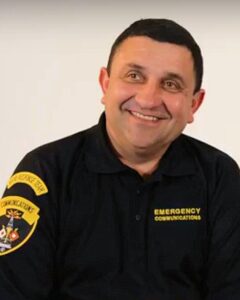
A key tenet of amateur radio is that “when all else fails,” ham radio is able to provide emergency communications.
What that really means was the topic of our July 19 Zoom meeting, when our speaker as Roozy Moabery, W1EH, District Emergency Coordinator for ARES NW and Baker2Vegas Medical Radio Network Communications Coordinator.
Roozy, who spoke to W6SD in 2022, discussed emergency communications and response, training, and the role of volunteer organizations such as ARES (the Amateur Radio Emergency Service), DCS (the Los Angeles County Disaster Communications Service), ACS (the Auxiliary Communications Service of the Los Angeles Fire Department) and others.
Roozy also serves on the Boards of Directors of Edulife, which provides classes on CPR, first aid and emergency medical procedures, and the Community Development Alliance of Greater Los Angeles, which focuses on housing and community issues.
Professionally, he is the Technical and Sales Training Manager for K.R. Nida Communication, which provides radio communications equipment and systems for emergency responders and businesses. He served in the United States Marine Corps from 1981 to 1994.
Saturday, June 22, 2024
Field Day, At Mason Park in Chatsworth
W6SD held our Field Day activities on Saturday, June 22, at Mason Park, 10500 Mason Ave., in Chatsworth.
We reserved Picnic Area 2 at the northeast corner of the park, near the intersection of Germain St. and Fulbright Ave.
We started setting up at 8 a.m., and operated from 11 a.m. to dusk. We then broke down and left the park; City rules do not permit overnight activity in parks.
The Club provided lunch, snacks and soft drinks.
The Mason Park location was selected after the Pierce College campus, which had been offered to us as a venue for 24-hour operation, became unavailable on short notice.
May 17, 2024
John Peyser, KM6LBW: The Art of Creating Catastrophe
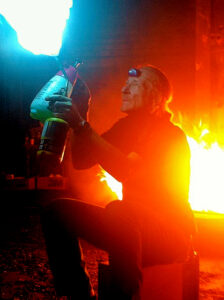
Many hams volunteer for “em comm” or emergency communications duty, preparing in case first responders need their assistance in the aftermath of an earthquake, fire, explosion, other serious but rare event.
Our May 17 speaker, John Peyser, KM6LBW, spent much of his career in the midst of disasters and catastrophes — which he carefully designed, crafted, and triggered, all while cameras recorded every detail of the resulting chaos.
John spent 40 years on the technical side of the motion pictures and television industries, working as a sound mixer, still photographer, and “mechanical special effects/pyrotechnics” technician. In that capacity he earned a California State Pyrotechnics Class 1 license, which cleared him to handle high explosives for the film industry.
He told us about some of the on-screen mayhem he has created for Warner Brothers, Universal, Paramount, MGM and 20th Century Fox.
His radio experience there was limited to using a walkie-talkie on set. It was only after he retired in 2017 that he had the time to pursue a long interest in ham radio, and quickly earned his Technician, General, and Extra licenses.
After joining W6SD early in his ham journey, he served as a Volunteer Examiner to help other hams get their licenses, and began serving as a Net Control Coordinator for our weekly on-air nets. In 2023, John was the inaugural recipient of W6SD’s Bill Stein Award for outstanding service to the club.This year he was elected as the club’s Technical Vice President.
April 19, 2024
Ed Fong, WB6IQN, on Tri-Band Antennas
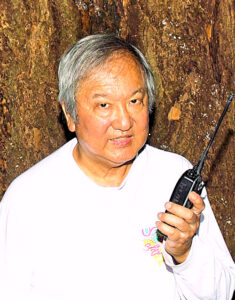
Our guest speaker for the April 19 meeting was Dr. Edison Fong, WB6IQN, the founder of Ed’s Antennas and inventor of the DBJ-1 and DBJ-2 antenna that was featured in the February 2003 and March 2007 QST.
The DBJ-1 is a highly effective dual-band VHF/UHF base station antenna, while the DBJ-2 is the portable roll-up version. The DBJ-2 won the QST Plaque of the Month Award. Both antennas are featured in the ARRL VHF Antenna Handbook, and also in the ARRL Antenna Classic Handbook. There are over 35,000 of these antennas in use today.
His most recent antenna is the TBJ-1, a tri-band base antenna (144-148 MHz, 222-225MHz, 440-450 MHz) that was featured in the March 2017 issue of QST.
Ed gave us a history on how these antennas were developed and the theory behind how they work and why they perform so well. There is no “black magic” to antennas; he explained this in a practical, non-mathematical manner.
While running a company that produces affordable, high-performance antennas, Dr. Fong also teaches RF Wireless Communications and other courses at the college level. He teaches graduate classes in RF Design and High Speed Interface Design as an instructor at the University of California Santa Cruz-Silicon Valley, and previously held a similar post at UC Berkeley.
Ed was first licensed in 1968 as WN6IQN. He later upgraded to Extra Class (with full 20 WPM CW) with his present call of WB6IQN. He obtained BSEE and MSEE degrees from the University of California at Berkeley, and his Ph.D. from the University of San Francisco.
A Life Senior Member of the IEEE, he has 12 patents and over 40 published papers and books in the area of communications and integrated circuit design. During his 30 year career he has performed worked for Motorola, National Semiconductor, Phillips Semiconductor and Advanced Micro Devices.
A video of Dr. Fong’s previous presentation to W6SD is on YouTube.
March 15, 2024
John Portune, W6NBC – Designing 2-Meter Yagi Antennas
John Portune, W6NBC, joined us via Zoom for our monthly meeting on Friday, March 15, to discuss the design principles involved in Yagi antennas for the 2-meter band.
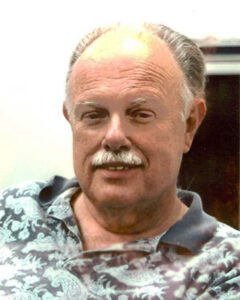
John, who spoke to us in 2023 and 2022, is a native of Los Angeles who now lives in Santa Maria, CA. He got his ham license in 1965, and is active on all bands from 160 meters to 2.4 GHz. He manages a remote HF/VHF base station on Vandenberg Air Force Base.
His ham activities have led him to contribute some three dozen articles to QST Magazne. His other interests include digital photography, cribbage, pipe organs and steam railroading.
John got his degree in physics at Oregon State University, then embarked on a successful career on the technical side of broadcast television, assisted by his earning a commercial radio license. He worked for KNBC Channel 4 in Los Angeles, and then with Ampex Corp. and Sony Corp. in Northern California, retiring in 2002.
To view John’s previous talks to us, see the W6SD YouTube videos page.
January 19, 2024
Natalie Gray, NW6S – A Tour of the Hollywood Glam Shack
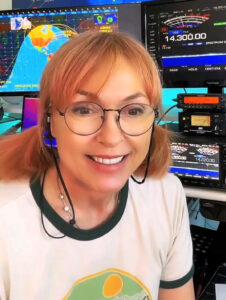
Natalie Gray, NW6S, our January 19 speaker, produces TikTok’s Glam Ham Radio. Her video series currently offers about 425 short-form videos that explain all aspects of our hobby. In less than two years, Glam Ham Radio has become the most popular ham radio channel on the TikTok platform, with nearly 58,000 followers.
Via Zoom, Natalie took us on a virtual tour of her ham radio shack and talked about how she got interested in ham radio.
We also heard how she finds time to record, edit and post her informative, entertaining and stylish videos at the pace of about four a week – all while managing a hectic multi-faceted career.
Born in Birmingham, England, as the daughter of a bass-playing rock musician, Natalie grew up in the entertainment industry, first hitting the stage as a young child. After her family relocated to Canada, Natalie acted on television, performing in over 100 TV episodes. She then moved to New York and later Los Angeles, finding success as an actress, stand-up comedienne, and podcaster.
As if that wasn’t enough to keep her busy, Natalie is also an artist and designer. A self-taught painter since childhood, she was commissioned to paint a reproduction of the Sistine Chapel Ceiling for a building on Sunset Blvd., and her abstract paintings have been sold in international auctions. In addition, she has designed footwear for leading shoe brands such as Birkenstock and Playboy, as well as furniture and lamps.
October 20, 2023
Dan Tomlinson, NR6V – Monitoring Public Safety Radio for Situational Awareness
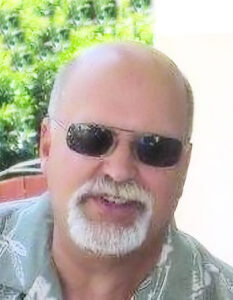
Our October speaker, Dan Tomlinson, NR6V, briefed us on the techniques and advantages of monitoring police, fire and other public service radio systems to stay aware of situations that may trigger the need for volunteer ham radio emergency communications assistance.
Topics Dan covered included: why and how we should monitor these systems; the terminology public service radio operators use on their systems; frequencies they use; and scanners Dan recommends.
Dan, whose background includes 20 years in law enforcement, has been a ham since 2009, with an Extra ticket since 2014. He is an active member of ARES LAX NW, and of LA City ACS. He is an active Volunteer Examiner with ARRL and GLAARG.
Dan is co-host (with Chris Mattia, W6AH, and David Goldenberg, W0DHG) of the Wavetalkers Training Series, which began as a way to help Ham Radio Operators obtain and upgrade their Amateur Radio License, and has expanded to cover emergency communications, digital operations, portable operating, and much more.
September 15, 2023
Tim Duffy, K3LR – Theory and Construction of Yagi Antennas in use at K3LR
Our September speaker, Tim Duffy, K3LR, discussed antenna theory and will go into detail about the construction of the Yagis installed at his remarkable shack.
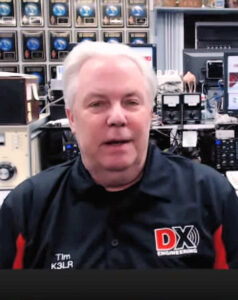
Tim is Chief Executive Officer of DX Engineering, a position he has held at the Tallmadge, Ohio, supplier of ham radio equipment, since January 1 of 2020.
His home station is designed and engineered for DX contest competition and HF emergency radio response, and his antenna farm features 13 towers with multiple rotatable dipoles, Yagis, stacked and phased arrays, and square and Moxon antennas, with approximately 25 miles of radials.
He has been a licensed ham since 1972, and is active in RACES, ACS and ARES. A member of the CQ Contest Hall of Fame, he was a member of Team USA for the World Radio Team Championship (WRTC) five times, is the founder and chairman of Contest University (CTU), and is chairman of the World Wide Radio Operators Foundation (WWROF).
He is the current president of The Mercer County Amateur Radio Club, past president of Mad River Radio Club, president emeritus of the Radio Club of America, and a Life Member of the American Radio Relay League and the ARRL Diamond Club.
Tim is a graduate of Pennsylvania State University.
August 18, 2023
Steve Moreen, KA6UGS – New FCC Rules on RF and Antenna Safety
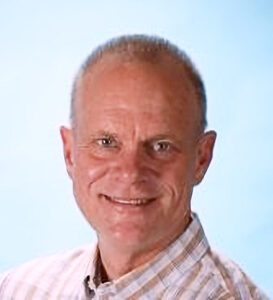
Steven K. Moreen, KA6UGS, gave us an update to the tutorial he presented two years ago on the new FCC rules for RF exposure.
The FCC has revised the rules and regulations concerning human exposure from radio transmitting stations. The rules went into effect June 1, 2020, but their effectiveness was delayed until May 3, 2021 for new stations, while existing stations had until May 3, 2023, to comply.
Before the new rules went into effect, most amateurs were able to use a Categorical Exclusion to the FCC requirement to determine if a station fell under the Maximum Permissible Exposure limit. The new rules replaced the Categorical Exclusions with a mechanism called Exemptions to Routine Evaluation. The Exemptions are based on frequency, power and distance.
Steve has developed an on-line worksheet which enables an amateur to determine if a station meets the Exemption to Routine Evaluation and the maximum station power allowed under the Exemption.
Steve explained how to use the Exemption Calculator worksheet, and will provide background information about meeting the FCC’s rules concerning Human Exposure to RF.
Steve graduated from Southern Illinois University, Carbondale, with a degree in Radio & Television Production. He was first licensed in 1966, and holds an Amateur Radio Extra license as well as a General Class Radiotelephone license. He retired after a 53-year career in radio/television/satellite communications technology, during which he held engineering and engineering management positions at numerous radio and television broadcast stations.
July 21, 2023
John Portune, W6NBC – Building and Using Mag Loop Antennas
Our July monthly meeting featured a presentation by John Portune, W6NBC, on the construction and use of magnetic loop antennas.
A video of John’s presentation is available on YouTube at https://youtu.be/6CaJokq_oIM.

A mag loop (or STL, small transmitting loop) antenna consists of a large coil equipped with a capacitor that brings the system to resonance. It is unlike the more common large resonant loop in that the loop size is smaller than 1/4 wavelength and does not resonate on its own.
By design, mag loop antennas are some of the best antennas for mitigating radio frequency interference (RFI) which is a problem in many QTHs. When oriented vertically, mag loop antennas can be rotated to null out unwanted signals on lower frequencies.
Because of their small size, mag loops are also fairly stealthy, and can often be deployed in locations where larger, more visually intrusive antennas cannot.
The downside of mag loops of the relatively small sizes used by most hams is that they have rather poor efficiency, and thus are more effective at lower frequencies as receiving antennas rather than for transmitting. Small loop antennas also have very low radiation resistance, resulting in power loss to heat with higher power levels.
John, who spoke to us in May of 2022, is a native of Los Angeles who now lives in Santa Maria, CA. He got his ham license in 1965, and is active on all bands from 160 meters to 2.4 GHz. He manages a remote HF/VHF base station on Vandenberg Air Force Base.
His ham activities have led him to contribute some three dozen articles to QST Magazne. His other interests include digital photography, cribbage, pipe organs and steam railroading.
John got his degree in physics at Oregon State University, then embarked on a successful career on the technical side of broadcast television, assisted by his earning a commercial radio license. He worked for KNBC Channel 4 in Los Angeles, and then with Ampex Corp. and Sony Corp. in Northern California, retiring in 2002.
He and his wife Rebecca, KF6OEB, have three married children and 12 grandchildren. In addition to ham radio, his other enthusiasms include steam railroading, the pipe organ, and sushi!
June 16 Monthly Meeting – Preparing for Field Day
Our June monthly meeting, led by Technical VP Randy Slaten, WB6UNG, focused on final preparations for Field Day, June 24-25, when many of our members will gather at Veterans Memorial Community Regional Park, in Sylmar.
With great sadness, W6SD reports the passing of club member Bill Stein, KC6T. Read more …
May 19 – Michael Hart, KC6MEH, on Fox Hunting
Michael Hart, KC6MEH, spoke to us via Zoom at 7:30 p.m. on Friday, May 19, about ham radio fox hunts, also known as treasure hunts.
The timing of this presentation was ideal, because Michael was hosting a fox hunt two days later: a 5-hidden-transmitter exercise at Chatsworth Park South, 22360 Devonshire Blvd., in Chatsworth.
In a fox hunt, one or several small, low-power transmitters are hidden, and hams equipped with direction-finding radio gear try to find them. It’s fun, challenging, and a great way to practice skills that can be used to locate a repeater jammer, or a lost hiker.
Michael and his wife Mary, KM6NCA, have hosted a number of fox hunts in our area.
Michael received his Tech license in 2016 and his General ticket a year later. He caught the directional finding “bug” while studying for his licenses with Norm (K6YXH) and Naomi (WB6OHW) Goodkin. Michael remembered doing CB radio directional finding with friends in the 1980s, and wanted to get back in to it.
What really caught his interest was the on-foot hunt. He hooked up with the Fullerton Amateur Radio Club, which regularly hosts on-foot hunts in parks from Santa Barbara to San Diego in the 2 meter and 80 meter bands. He likes to call these hunts “Hiking with a Mission,” and “The Most Exercise You’ll Get With Your Radio.”
April 21 – Diana Feinberg, AI6DF, on Portable Solar Generators
Diana Feinberg, AI6DF, spoke to us via Zoom on Friday, April 21, at 7:30 p.m. on “All About Portable Solar Generators.”
A video of her talk is available on YouTube.
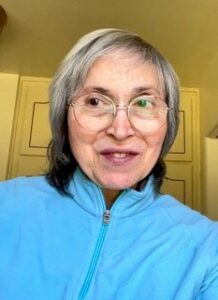
Her presentation covered: the evolution and growth of these amazingly-useful products; criteria for comparing models across market-leading brands; specific features that might be important for different situations; and the current “Wild West” nature of this product category.
She also discussed solar panel considerations for portable solar generators.
Diana has served as President of the Palos Verdes Amateur Radio Club (K6PV) since 2012, and as ARRL Los Angeles Section Manager since 2016.
Her public service activity currently is primarily with the Los Angeles Marathon and the L.A. County Disaster Communications Service (overseen by the Sheriff’s Department), for which she developed an earlier version of this solar generator presentation.
She previously served as President of the 220 Spectrum Management Association; Chair of the Los Angeles Area Council of Amateur Radio Clubs; and Chair of the 2015 and 2017 HAMCON ARRL Southwestern Division conventions held in Torrance.
After earning an MBA degree, she spent 24 years in managerial and executive positions with three large consumer products firms before leaving the corporate world to “get a life” and into amateur radio.
March 17, 2023:
Richard Donner, WA6KYR: A History of Broadcasting, From Marconi to the Crystal Radio
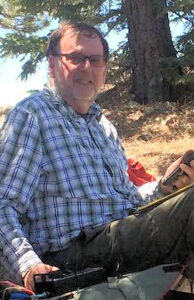
It’s easy for today’s hams to forget that the powerful, sophisticated and convenient transceivers we use today are relative newcomers to radio communications, and that previous generations of hobbyists accomplished remarkable feats with primitive, balky, often home-brewed equipment.
Richard Donner, WA6KYR, who spoke at our March 17 meeting on Zoom, has been a ham since 1960 and member of our club for four decades. He became interested in the history of radio during the pandemic, and began building crystal radios to learn more about what our forebears had to cope with. The results was several sets that are beautiful and informative examples of their genre.
Along the way, Richard delved deeply into the history of our hobby, going back to the work of Guglielmo Marconi, the Italian nobleman, self-taught engineer and inventor who is credited as the inventor of practical, radio-based wireless telegraphy, for which he earned the Nobel Prize in 1909. (Marconi’s Irish mother, Annie Jameson, an heiress of the Jameson Whiskey dynasty, enthusiastically supported his experiments in Italy and later in Britain with funds indirectly provided by fans of the family’s spirits.)
Richard earned his novice license at 16 and his general ticket a year later, using Heathkit hardware and surplus parts. He did his undergraduate and graduate studies at UCLA, in structural mechanics, and took a hiatus from ham radio for some years. He returned to the hobby in the mid-1980s, and became an active member of W6SD, serving at club Secretary and participating in some 30 Field Day exercises.
He is an active SOTA operator, activating local summits with QRP CW when weather permits and chasing activators via Morse code and sideband from his shack at his Newhall QTH.
A video of Richard’s presentation can be seen on YouTube at https://youtu.be/_A139yHmsUg
February 17 Monthly Meeting
John Portune, W6NBC: A Dummy’s Guide to Making Ferrite Toroid Baluns
John Portune, W6NBC, was scheduled to speak to us, but had to cancel because of a scheduling conflict. Instead we viewed one of his many informative YouTube videos, and had a useful discussion of the topic. We are looking forward to having him rejoin us for a future meeting.
January 20, 2023
Tim Duffy, K3LR, on Grounding and Bonding
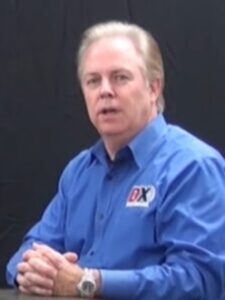
There’s likely to be a lot of electrical power involved in getting your phone, CW or other signal out of your shack and on its way to hams elsewhere in the world. Connecting your equipment to a good ground, and bonding various pieces of gear to each other, makes sure that power doesn’t go where it doesn’t belong, causing shocks or more serious problems.
Our January speaker, Tim Duffy, K3LR, explained why grounding and bonding are important, and show best practices in making sure those steps are done correctly. A video of his presentation is on YouTube.
Tim is Chief Executive Officer of DX Engineering, a position he has held at the Tallmadge, Ohio, supplier of ham radio equipment, since January 1 of 2020. He has been a licensed ham since 1972.
He is active in RACES, ACS and ARES. Tim is a member of the CQ Contest Hall of Fame. He was on Team USA for the World Radio Team Championship (WRTC) five times, is the founder and chairman of Contest University (CTU), and is chairman of the World Wide Radio Operators Foundation (WWROF).
He is the current president of The Mercer County Amateur Radio Club, past president of Mad River Radio Club, president emeritus of the Radio Club of America, and a Life Member of the American Radio Relay League and the ARRL Diamond Club.
His home station is designed and engineered for DX contest competition and HF emergency radio response, and his antenna farm features 13 towers with multiple rotatable dipoles, Yagis, stacked and phased arrays, square and Moxon antennas, with approximately 25 miles of radials.
Tim is a graduate of Pennsylvania State University.
Sunday, December 11, 2022
Holiday Lunch at Maggiano’s Little Italy, Woodland Hills
This year our club’s annual holiday get-together was a luncheon at the popular Maggiano’s Little Italy restaurant, at 6100 Topanga Canyon Blvd. in Woodland Hills, on Sunday, December 11, starting at 11 a.m
November 18, 2022, Monthly Meeting
Cliff Cheng, AC6C, on Lenore Jensen, One of Ham Radio’s Most Famous YLs
For thousands of members of the US military stationed in Vietnam, Okinawa and other locations far from home, their most reliable link to home was via a ham radio phone patch set up by Lenore Jenson, W6NAZ.
Cliff Cheng, AC6C, talked about the many accomplishments of this remarkable ham at our monthly meeting Friday, November 18, 2022, on Zoom.
Lenore, born in 1913, became one of amateur radio’s most prominent operators. At the time of her death in 1993 she was widely considered the hobby’s most famous YL (woman).
In 1939 she co-founded the YL Radio League. During World War II she founded a radio course for women through the American Women’s Voluntary Services and taught CW (Morse code) to the U.S. Navy.
In the 1950s she ran phone patches for U.S. Air Force personnel stationed at remote bases such as Antarctica and Greenland. She also ran a USO net which made phone patches for service members.
During the Vietnam War she made tens of thousands of phone patches for GIs from her home in Sherman Oaks, enabling them to phone home via ham radio from the combat zone.
She promoted amateur radio by using her media contacts she gained, as an actress and produced public service announcements with major celebrities. She appeared on a number of radio and TV programs to promote the hobby, and in 1983 was presented with a Special Achievement Award at the Dayton Hamfest.
She was honored for her accomplishments by the television program “This is Your Life. ”
In 2008 she was posthumously inducted into the CQ Amateur Radio Hall of Fame. We are honored that Lenore and her husband, Bob, were longtime and active members of W6SD, the San Fernando Valley Amateur Radio Club.
October 21, 2022 Monthly Meeting
Julian Vargas, N1CA — Operating as a Ham While Blind
Someone who is blind or visually impaired confronts special challenges with everyday tasks, such as using a smartphone or computer, navigating a crosswalk controlled by a traffic signal, selecting our clothes, and much more.
In the world of ham radio, where most of us rely on knobs, buttons, labels, visual displays of letters and numbers, lamps that change color and brightness, and spectrum scopes, those difficulties might seem insurmountable.
Yet Julian Vargas, whose Amateur Extra call sign is N1CA, has been on the air for more than three decades despite being legally blind due to a rare genetic condition known as Leber Congenital Amaurosis, or LCA. His vision, limited since birth, declined even more after about 2003, when he was 33.
Julian is a voracious adopter of technology, teaching himself how to use assistive devices and systems for computers and phones. Collaborating with other visually impaired hams, he figured out ways to use handheld and base station radios, often with modifications to firmware or other systems.
He has built a successful career training others on how to use assistive technology, and consulting with companies on how to make their products more user-friendly to those with visual impairments. He frequently speaks about these issues at conferences, state and federal legislative hearings, and on radio and TV programs.
September 16, 2022 Monthly Meeting
Andy Pattantyus, KF0ARA: A First-Year Ham’s Perspective
Some of us may have gotten our start in the hobby of amateur radio decades ago, while for others the excitement of passing our Tech exam may be a much more recent memory.
But what is it like to take the first steps on the ham journey today, when radios are essentially computers, technologies like DMR are providing exciting new options, and the Internet (including Zoom) has changed the way we learn, exchange information and even socialize?
We got a fresh perspective at our September 16, 2022, monthly meeting from Imre “Andy” Pattantyus, KF0ARA, who got his license (as a General) in June of 2020. Andy is the club secretary for the Black Hills Amateur Radio club, call sign W0BLK.
Andy, based in Rapid City, SD, is a mechanical engineer and project manager with Turner Engineering Corporation, doing railway safety assurance for passenger rail rolling stock and wayside equipment.
Some of Andy’s work deals with electromagnetic interference compatibility and compliance, and the ham radio learning curve is helping Andy better understand EMI limits and measurements.
Andy is also experienced in battery manufacturing, lean manufacturing, and strategic planning.
Andy did his undergraduate work in mechanical engineering at Virginia Tech, where he went on to get a master’s in the same field. He then earned an MBA at Case Western.
August 19, 2022 Monthly Meeting
Cory Gibson, W3JL, on NVIS: Close-In Communications
An HF rig powering a Yagi on a tower can get your signal to another ham halfway around the world, and a small handheld radio will easily handle line-of-sight communications nearby. But what about connecting you with all of the points in between?
That’s where NVIS comes in. Near-Vertical Incidence Skywave was the topic of the presentation at our monthly meeting Friday, Aug. 19, 2022, by Cory Gibson, W3JL. NVIS is a key mode of communication for a wide range of locations and circumstances, including but not limited to EmComm (emergency communications.)
Cory has been a ham since 2012, building on his lifelong interest in radio and his formal training in electrical engineering. That fits well with his professional role as Design and Production Manager at DX Engineering, one of the nation’s largest retailers of amateur radio equipment.
Cory, who spoke to us via Zoom from his home in Atwater, OH, is the Vice-President of the Mercer County (Ohio) Amateur Radio Club, where he runs the email server and website.
Previously he was the Emergency Coordinator and Radio Officer for Mercer County, and he continues to participate in drills for emergency communications.
When not working or playing with electronics and radios, Cory can be found with his wife Laura, N3BSN, their three-year old-daughter, two dogs and and horse, often out in the woods or canoeing on a river or lake in Canada.
July 15, 2022 Monthly Meeting
Roozy Moabery, W1EH, on Emergency Communications
A key tenet of amateur radio is that “when all else fails,” ham radio is able to provide emergency communications.
What that really means was the topic of our July 15 Zoom meeting at 7:30 p.m., when our speaker was Roozy Moabery, W1EH, District Emergency Coordinator for ARES NW and Baker2Vegas Medical Radio Network Communications Coordinator.
Roozy, who spoke to W6SD in 2019, will discuss emergency communications and response, training, and the role of volunteer organizations such as ARES (the Amateur Radio Emergency Service), DCS (the Los Angeles County Disaster Communications Service), ACS (the Auxiliary Communications Service of the Los Angeles Fire Department) and others.
Roozy also serves on the Boards of Directors of Edulife, which provides classes on CPR, first aid and emergency medical procedures, and the Community Development Alliance of Greater Los Angeles, which focuses on housing and community issues.
Professionally, he is the Technical and Sales Training Manager for K.R. Nida Communication, which provides radio communications equipment and systems for emergency responders and businesses. He served in the United States Marine Corps from 1981 to 1994.
June 17 Monthly Meeting
Preparations for Field Day, June 25-26
Our June monthly meeting was devoted to discussion of preparation for Field Day, which was held on Saturday and Sunday, June 25-26.
We operated out of Veterans Memorial Community Regional Park, at 13000 Sayre St, Sylmar, CA 91342.
May 20 Monthly Meeting
John Portune, W6NBC, on The Cavity Duplexer
The repeaters that so many hams rely on have to accomplish a seemingly impossible task: allow a very sensitive receiver and a very powerful transmitter to operate at the same time on the same antenna — while also isolating the repeater from other radios that may be operating nearby.
The device that manages this difficult balancing act is the cavity duplexer. Remarkably, a ham with average do-it-yourself skills and some basic hand tools can build a very effective duplexer, as John E. Portune, W6NBC, discovered years ago when he set out to build one in his workshop. Ever since then, John has been experimenting with duplexers and helping guide countless other hams to make their own.
A video of John’s presentation to W6SD on cavity duplexers is available on YouTube.
A native of Los Angeles and now a resident of Santa Maria, CA, John got his degree in physics at Oregon State University, then embarked on a successful career on the technical side of broadcast television. He worked for KNBC Channel 4 in Los Angeles, and then Ampex Corp. and Sony Corp. in Northern California, retiring in 2002.
He got his ham license in 1965, and is active on all bands from 160 meters to 2.4 GHz. He manages a remote HF/VHF base station on Vandenberg Air Force Base.
His ham activities have led him to contribute more than two dozen articles to QST Magazne. His other interests include digital photography, cribbage, pipe organs and steam railroading.
He and his wife Rebecca, KF6OEB, have three married children and 12 grandchildren.
April 22 Monthly Meeting
Randy Slaten, WB6UNG: a Shack Tour
We joined Randy, our Tech VP, for a virtual tour of his shack. We saw his rigs, antenna systems and other gadgetry, and learned why he chose them and how he uses them.
March 18, 2022 Monthly Meeting
Nick Tusa, K5EF, on West Schum: Amateur Radio’s Unsung Hero
Nick Tusa, K5EF spoke about his book featuring Wes Schum W9DYV: Amateur Radio’s Unsung Hero. It demonstrates our hobby’s many important contributions to the art and science of radio, including the development of the Single Side Band (SSB) operating mode.
Wes Schum’s mission to bring SSB to ham radio resulted in the development of what became the very popular Central Electronics Model 10A. Nick will take us through development of the Model 10A prototype and the ultimate adoption of SSB by hams worldwide.
Nick also talked about how his early radio experience led to his current occupation regarding site reliability and readiness in the commercial communications sector.
For more than 42 years Nick has provided technical services involving the design, implementation and maintenance of radio and microwave communication systems for public safety organizations, including 911 systems, and private industry.
Nick earned his first Amateur Radio license at age 11, and has been continuously active in the hobby for 57 years.
February 18, 2022 Monthly Meeting
Alan Wolke, W2AEW, on the NanoVNA
Alan Wolke, W2AEW, discussed the NanoVNA handheld vector network analyzer, with an emphasis on using its Smith Chart capability to check antenna and transmission line characteristics.
A video of his presentation is available on YouTube.
Alan is an RF applications engineer by profession, and a dedicated ham radio educator and Elmer via his prodigious YouTube channel and his many ARRL and club activities.
He earned his Electrical Engineering degree in 1985 from the New Jersey Institute of Technology. His early career focused mainly on analog/high-speed design, test and applications engineering in various fields ranging from fiber optic communications to hard disk drives.
Since 2006, he has been a Field Applications Engineer for Tektronix, focusing mainly on RF Applications. These include radar/electronic warfare, RF communications, RF device characterization, spectrum monitoring, surveillance and much more. He has worked with the military, government agencies, prime contractors, and commercial customers throughout the northeastern part of the country.
Alan was originally licensed in 1980 while in high school as KA2IZZ, and currently holds an Extra class license. He is a life member of the ARRL, and is the Technical Coordinator for the Northern New Jersey Section of the ARRL Field organization.
His favorite ham radio activities are operating CW and SSB on the HF bands, with occasional QRP and portable operations. Outside of ham radio, Alan enjoys tinkering at the electronics workbench and producing videos for his popular YouTube channel, which has nearly 350 videos, over 164,000 subscribers, and over 20 million views.
Alan joined us from his New Jersey home via Zoom.
January 21, 2022
Dr. Jack Nilsson, N8NDL, of COMPACtenna
See a video of this presentation on YouTube.
Dr. Jack Nilsson, N8NDL, is the inventor of the COMPACtenna, which as the name of the novel design suggests are small in size yet deliver the performance of much larger antennas.
The UHF COMPACtenna, for the 70cm, 1.25m and 2m bands, comes in 7.5-inch and 9-inch versions for mounting on vehicles. A model designed for stationary use, which covers UHF and the 20m band, is just 20 inches tall.
The patented design uses metal sheeting in spiral and cylindrical forms, including “extended flat monofilar spiral Tesla-like coils,” with the result that resistance, inductance and capacitance, or matching, is performed by the geometry of the antenna rather than by added electronic components.
Dr. Nilsson has 30 years of antenna and electromagnetic engineering experience, from concept, design, test, production, integration, modelling and simulations.
He holds 15 antenna-related patents related to two-way communications, aerospace communications, automotive, IoT, cellular, broadcast AM/FM, WiFi, GPS, Bluetooth and other applications.
He has designed novel Yagi’s, collinear Omni’s, stacked beams, reflectors, horns, phased arrays, loop, dipole, PIFA, multi-polarized and many other antennas.
In addition to ham radio operators, his antennas have been used by the Secret Service, Department of Homeland Security, WiFi and cellphone systems, public service agencies, ambulance systems and many others.
Jack earned his undergraduate and M.D. degrees from the University of Akron, with honors. He was awarded the Silver Medal by the Mathematics Association of America, and received a Formal Technology Honor from the U.S. Secret Service.
He joined us via Zoom from Strongville, Ohio, where COMPACtenna is based.
December 4, , 2021 Holiday Party
Our party was held at Knollwood Country Club
November 19, 2021
Steve Moreen, KA6UGS, on New FCC Rules for RF Exposure
Steve Moreen, KA6UGS, presented a tutorial on the new FCC rules for RF exposure.
The FCC has revised the rules and regulations concerning human exposure from radio transmitting stations.
The new rules went into effect June 1, 2020. However, their effectiveness was delayed until May 3, 2021, and existing stations have until May 3, 2023, to comply. New stations must comply after May 3, 2021.
Before the new rules went into effect, most amateurs were able to use a Categorical Exclusion to the FCC requirement to determine if a station fell under the Maximum Permissible Exposure limit.
The new rules replaced the Categorical Exclusions with a new mechanism called Exemptions to Routine Evaluation. The Exemptions are based on frequency, power and distance.
Steve Moreen, KA6UGS, has developed an on-line worksheet which enables an amateur to determine if a station meets the Exemption to Routine Evaluation and the maximum station power allowed under the Exemption.
Steve explained how to use the Exemption Calculator worksheet, and will provide background information about meeting the FCC’s new rules concerning Human Exposure to RF.
Steve was first licensed in 1966. He holds an Amateur Radio Extra license as well as a General Class Radiotelephone license.
He recently retired from a 53-year career in radio/television/satellite communications technology, during which he held engineering and engineering management positions at numerous radio and television broadcast stations.
Steve graduated from Southern Illinois University, Carbondale, with a degree in Radio & Television Production.
October 15, 2021
Bob Heil, K9EID
Bob Heil, K9EID, is founder of Heil Sound, which supplies microphones and headsets used by ham radio enthusiasts around the world, in addition to audio products used by commercial broadcasters, sound engineers and recording artists.
Bob, who spoke to us in March about the general topic of ham radio sound, returned to discuss some of these issues in more depth — and to answer questions from us.
Born in 1940, Bob became a proficient theater organ musician at a young age and by 15 was the house player for the Wurlitzer theater organ at the Fox Theater in St. Louis. He credits tuning the thousands of pipes in the instrument with teaching him to listen to discrete tones, a skill that contributed to much of his career in sound.
He got his ham radio ticket in his teens, and began designing and building homemade transmitters, amplifiers, and antenna systems.
A legend in amateur radio, Bob understood early in his career as a microphone designer that voice articulation is key to ham radio, for emergency use as well as for the hobbyist. His ham radio products are a result of that level of concern for the voice. Recognizing that not all ham radio rigs are created equal, his team focus on designing mics and headsets that perform well with specific transceivers.
Bob is a sound and radio engineer credited for creating the template for modern rock sound systems. Heil Sound, which he founded in Fairfield Heights, IL in 1966, has created touring sound systems for bands such as The Grateful Dead and The Who. His company also manufactures microphones and satellite dishes for broadcasters and live sound engineers.
He has won multiple awards and honors, and in 2007 he became the first manufacturer to be invited to exhibit at the Rock and Roll Hall of Fame. Heil microphones can be found on concert stages, in churches, performance venues, recording studios and broadcast facilities worldwide.
September 17, 2021
Mark Chung, KK6SMD, on Weather, Ham Radio and the Skywarn Program
A retired Navy medical officer, Mark Chung decided to use Ham Radio as his contribution to supporting Homeland security. He was a founding member of a radio club, the Cerritos Amateur Radio League, in his home city, and teaches Technician and General classes at the Red Cross and support emergency communications.
Mark got his ham radio license in 2015, and moved up from Tech to General to Extra in just three months. His wife and two daughters are hams.
Associated Radio Amateurs of Long Beach named him Ham of the Year in 2015 and 2018.
He has served as Disaster Communications Lead and on the Board of the American Red Cross, Greater Long Beach/Rio Hondo/South Bay Chapter, as Assistant Section Manager for ARRL Los Angeles region, and as an ARALB Director, ARALB Field Day chair.
Mark gives presentations and teaches license classes on behalf of the Red Cross and ARALB.
August 20, 2021, 2021
Robert Brehm, AK6R – End-Fed Antennas
Our speaker, Robert C. Brehm, AK6R, discussed end-fed antennas. Bob is Chief Engineer at Palomar Engineers, Inc., which makes antennas, baluns, RFI kits and other ham radio accessories.
First licensed in 1963, Bob went on to earn his Advanced and Extra licenses, and also holds First Class Commercial and General Radiotelephone Operator licenses. He’s active in contesting on CW, RTTY and SSB, and likes to restore old tube radio gear.
July 16, 2021
Orville ‘Orv’ Beach, W6BI, on AREDN Mesh
Orv Beach,W6BI, first licensed in 1967, has been involved in digital mesh radio since 2014. A resident of Simi Valley, he is a member of the Simi Settlers Amateur Radio Club.
He spoke to us via Zoom about using mesh links on AREDN, the Amateur Radio Emergency Data Network. AREDN is a high-speed data network using Internet protocols that provides important backup to other forms of emergency communications.
The AREDN Mesh network uses low-power, low-cost equipment including transmitters running under FCC Part 97.
Transmitters typically operate on 900 MHz, 2.4 GHz, 3.3 GHz, and 5.8 GHz, with power under one watt and communicating line-of-sight in self-configuring, self-healing networks of multiple links. The basic component is often an inexpensive home WiFi router that has been “flashed” to operate in the Amateur Radio private network.
Field Day: June 26-27, 2021
W6SD at Pierce College
The San Fernando Valley Amateur Radio Club was at Pierce College on June 26-27 for Field Day.
For those new to ham radio, Field Day is ham radio’s open house. On the last weekend of every June, more than 40,000 hams throughout North America set up temporary transmitting stations in public places to demonstrate ham radio’s science, skill and service to our communities and our nation.
Field Day combines public service, emergency preparedness, community outreach, and technical skills all in a single event. It has been an annual event since 1933, and remains the most popular event in ham radio.
We operated under the special call sign W6S, in celebration of the 75th anniversary of the founding of W6SD.
Thanks to the generous assistance of Pierce College’s Dr. Brian Silk, W6NFV, our Club was given access to facilities of the Campus near the El Rancho Drive entrance from DeSoto Ave. (Click for a map.)
June 18, 2021
Oliver Dully, K6OLI, on Winlink
Our speaker at the W6SD monthly meeting at 7:30 p.m. on June 18 was Oliver Dully, K6OLI, who will talk to us via Zoom about Winlink Global Radio Email. He provided an overview of Winlink and show how hams use it for emergency communications. You can see a video of the presentation on YouTube.
Oliver is member of the Winlink Development Team (WDT) and has authored several popular Winlink Quick Guides for Packet and VARA FM.
He is the coordinator for the Winlink Did-you-feel-it (DYFI) project, a WDT collaboration with the United States Geological Survey, and co-author of the EOS article “Amateur Radio Operators Help Fill Earthquake Donut Holes”. He is one of the initiators of the VARA FM Winlink Autobahn covering Los Angeles and Ventura Counties.
Oliver also serves as District Emergency Coordinator for ARES LAX Northeast, which provides amateur radio communications backup for 911 receiving hospitals in northeastern Los Angeles County. Operators with ARES LAX Northeast use innovative technologies like Winlink with VARA HF, VARA FM, Packet and AREDN mesh to provide amateur radio solutions for the complex communications demands of medical facilities when commercial options may have been compromised.
With his friends, Oliver enjoys supporting events like the AC100 UltraRace and the Baker2Vegas Relay Cup Race. He and Tran Huynh, K6NHI, live in Pasadena, CA.
May 21, 2021
Kevin Zanjani, KI6DHQ
Kevin Zanjani, KI6DHQ, National Sales Manager at Santa Ana-based Bioenno Power, gave us an in-depth introduction to LiFePO4 batteries and their use in ham radio and solar applications.
Bioenno Power provides advanced power solutions centered on an advanced Lithium-ion power unit called Lithium Iron Phosphate (LFP).
LFP batteries are one of the most advanced forms of Lithium-Ion batteries commercially available. They offer greatly enhanced characteristics that conventional lead-acid batteries and even other lithium-based batteries cannot match.
This exciting presentation will discuss typical radio and other applications for these state-of-the-art batteries, and will have a show-and-tell of Bioenno’s various products.
Bioenno Power has exhibited at the Dayton Hamvention, Orlando Hamcation, PacifiCon, Visalia DX Convention, among others events, and its products have been featured in CQ Magazine, QST Magazine, HamNation and other publications.
Kevin holds a BSEE, MSECE, and MBA degrees.
April 16, 2021
Gordon ‘Gordo’ West, WB6NOA
Gordon West, or ‘Gordo’ to his friends and fans, is one of the best-known educators in the ham community. He is the author of a best-selling series of study guides for amateur radio licensing tests, operates the Gordon West Radio School, and hosts Ham Nation on TWIT.TV with Bob Heil.
Gordo has been teaching radio and electronics for more than 40 years. His fun approach helps make learning the material enjoyable and easy to recall for testing. He is a leading convention speaker, DX’er, teacher and author.
He spoke to W6SD via Zoom about ham radio and emergency communications. A video of his talk is on YouTube.
Gordo has been involved in ham radio for over six decades, having obtained his first ticket at age 15. He has been honored as “Instructor of the Year” By the ARRL, Fellow of the Radio Club of America, and Hamvention, “Man of the year for 2006.”
Gordo has earned respect among hams for his clearly written and to-the-point study guides. In addition, he regularly offers free classes to introduce kids to the world of radio, and for cities to support their CERT members.
He and his wife Suzy, N6GLF, who teaches marine radio classes, live in Costa Mesa.
March. 19, 2021
Bob Heil, K9EID
A video of Dr. Bob Heil’s presentation is on YouTube.
Bob Heil, K9EID, is founder of Heil Sound, which supplies microphones and headsets used by ham radio enthusiasts around the world, in addition to audio products used by commercial broadcasters, sound engineers and recording artists.
Born in 1940, he became a proficient theater organ musician at a young age and by 15 was the house player for the Wurlitzer theater organ at the Fox Theater in St. Louis. He credits tuning the thousands of pipes in the instrument with teaching him to listen to discrete tones, a skill that contributed to much of his career in sound.
He got his ham radio ticket in his teens, and began designing and building homemade transmitters, amplifiers, and antenna systems.
A legend in amateur radio, Bob understood early in his career as a microphone designer that voice articulation is key to ham radio, for emergency use as well as for the hobbyist. His ham radio products are a result of that level of concern for the voice. Recognizing that not all ham radio rigs are created equal, his team focus on designing mics and headsets that perform well with specific transceivers.
Bob is a sound and radio engineer credited for creating the template for modern rock sound systems. Heil Sound, which he founded in Fairfield Heights, IL in 1966, has created touring sound systems for bands such as The Grateful Dead and The Who. His company also manufactures microphones and satellite dishes for broadcasters and live sound engineers.
He has won multiple awards and honors, and in 2007 he became the first manufacturer to be invited to exhibit at the Rock and Roll Hall of Fame. Heil microphones can be found on concert stages, in churches, performance venues, recording studios and broadcast facilities worldwide.
Feb. 18, 2021
Ed Fong, WB6IQN, of Ed’s Antennas
A video of Dr. Fong’s presentation is on YouTube.
Ed Fong is best known to hams as the designer and manufacturer of a range of affordable, high-performance antennas, including the TBJ-1, DBJ-1, DBJ-2 and DBJ-UHF antennas. More than 23,000 of his antennas have been sold.
Somehow he manages to create new antennas and run a busy company while teaching RF Wireless Communications and other courses at the college level!
Ed was first licensed in 1968 as WN6IQN. He later upgraded to Extra Class (with full 20 WPM CW) with his present call of WB6IQN. He obtained BSEE and MSEE degrees from the University of California at Berkeley, and his Ph.D. from the University of San Francisco.
A Life Senior Member of the IEEE, he has 12 patents and over 40 published papers and books in the area of communications and integrated circuit design.
Presently, he is employed by the University of California (previously at Berkeley and presently at Santa Cruz-Silicon Valley) as an instructor, teaching graduate classes in RF design and High Speed interface design.
During his 30 year career he has performed worked for Motorola, National Semiconductor, Phillips Semiconductor and Advanced Micro Devices.
Jan. 15, 2021
David C. Hodge, N6AN: Propagation Tools Yesterday, Today and Tomorrow
Propagation is the behavior of radio waves as they travel, or are propagated, from one point to another — which for us ham radio operators means getting from our rig and antenna to those of a ham somewhere else in the world. There are many helpful tools we can use to raise the odds of a successful QSO or ragchew session, as David will discuss.
Licensed since the age of 14 and an active ham for more than half a century, David has been an orchestral musician, broadcast engineer and most recently a member of the Caltech radio astronomy team, its electrical engineering staff, and the Caltech Amateur Radio Club (CITARC, callsign W6UE).
The meeting was held on Zoom.
Dec. 18, 2020
Jeff Edelstein, Owner, SOS Survival Products
An important part of amateur radio operations is emergency communications. But you can’t be the provider of “when all else fails” radio service if you don’t have food, water, shelter and other necessities. We heard all about that at our December 18 monthly Club meeting from Jeff Edelstein, an expert on the topic. Jeff’s Van Nuys-based company, SOS Survival Products, can provide virtually everything to keep you and your loved ones safe and secure during and after a crisis.
That begins with emergency supplies of food and water, but also includes first aid supplies; sleeping bags; tents; sanitation and hygiene supplies; lighting equipment from flashlights to industrial generators, solar panels and inverters; fire extinguishers; disinfectants; earthquake fasteners; and much, much more.
For more than a dozen years Jeff has also hosted training programs on emergency preparedness, radio communications for hams and others, first aid, even how to care for pets in a disaster situation.
The meeting was held on Zoom.
Nov. 20, 2020
Diana Feinberg, AI6DF, ARRL LA Section Manager
Diana Feinberg, AI6DF, has served as the ARRL Los Angeles Section Manager since June 1 of 2016. She talked to us about a number of issues ARRL is addressing on behalf of ham radio operators. These include the FCC’s proposal to increase fees for licenses and renewals, and the agency’s plans to reassign the 3.5 GHz band, now used by hams for mesh networks, and the 5.9 GHz band.
Diana also discussed how the COVID-19 pandemic has affected ham radio, and how those impacts may persist after the emergency ends and we enter a “new normal” era.
A resident of Palos Verdes Peninsula, Diana is very active in the Palos Verdes Amateur Radio Club, K6PV, and has served in several other radio organizations.
Despite living in a building whose homeowners association does not allow external antennas, she has accumulated a very robust logbook of contacts around the world mostly running 100 watts or less to a wire dipole in her upstairs bedroom.
The meeting was held on Zoom.
Oct. 15, 2020
James Flynn on CSUN CubeSat Project
Many hams enjoy building their own gear, but few have taken it as far – literally – as James Flynn, WB9AWX, our speaker for the monthly meeting of W6SD on Friday, Oct. 16.
A project Jay (as he’s known to his friends) began four years ago with students at Cal State University–Northridge, where he is an instructor in the Engineering Department. It culminated with the successful launch of a cubesat (a small satellite) named CSUNSat1 into orbit 400 kilometers above the earth.
A joint mission with JPL, the project involved 70 students who not only helped design and build the satellite but put together and staffed the ground station that collected data on its use of an innovative energy storage system. Many of the students went on to careers in aerospace or technology.
An active ham since 1969, Jay was working as a film and television engineer when he went to the Visalia DX Convention years ago and happened to meet Dr. Sharlene Katz, WB6FFE, then a professor at CSUN. Dr. Katz soon persuaded him to join the school’s faculty, and was project lead at CSUN for the cubesat project.
September 25, 2020
Our speakers were Jim Aspinwall, NO1PC, and David Godlenberg,W0DHG. They discussed how ham radio hobbyists have provided support to their communities during the COVID-19 pandemic, and touched on WinLink, DMR and other topics.
See the YouTube video of the meeting.
August 21, 2020
How To Get On The Air With Digital Mobile Radio
Bernard Falkin, KG6FBM, provided us with a comprehensive introduction to DMR, Digital Mobile Radio at our first virtual monthly meeting via Zoom, on Aug. 21.
Bernard talked about what DMR is, the radios available to hams, how to get on the air, how DMR works, how you can talk with hams around the world with a handheld, and much more.
February 21, 2020
What Sunspots and the Solar Cycle Mean To You
Our speaker was Ken Larson, KJ6RZ, who explained how long distance HF radio communication is affected by sunspots and the solar cycle.
The longer radio waves of the HF bands can reach from your transmitter to a receiver thousands of miles away if they bounce off charged particles in the region of Earth’s upper atmosphere known as the ionosphere.
But the ionosphere’s ability to reflect your signal back to the surface, rather than letting it continue on into space, is largely determined by the sun.
Bursts of solar energy can ionize portions of the upper atmosphere, dramatically improving long-distance radio communication, while periods of lower solar energy can mean poorer conditions and “dead” bands. The sun’s influence varies on an 11-year cycle, as well as through frequent shifts in solar flux and even geomagnetic storms.
Ken explained how the sun affects ham radio, where we are in the solar cycle, and how a better understanding of these phenomena can enable us to maximize our enjoyment of the hobby.
January 17, 2020
Our speaker was Randy Slaten, WB6UNG, who talked about erecting a tower and beam antenna at his home in Woodland Hills.
Randy bought the tower from a local ham who was moving, and took it down with the help of some friends.
Then came the “minor details” of transporting everything to his home, digging a massive hole in his patio, pouring a multi-ton concrete foundation, erecting the tower and mounting his antennas.
It took some time, but Randy is now enjoying the benefits of an impressive antenna farm!
December 8, 2019
We held our annual Holiday Party at the Knollwood Country Club, in Granada Hills, introducing our 2020 Board Members and thanking retiring board members Ginger Wonderling, AB6YL, John Tibbetts, W9APX and Tom Peabody, K6TGP. Bernard Falkin, KG6FBM, presented a slide show of past club activities, and Mark Weiss, K6FG, spoke about his new role as Southwestern Division Director for the ARRL.
November 15, 2019
Our speaker was Jerry Wanger, KK6LFS, president of Connect Systems.
Based in Agoura Hills, Connect Systems manufactures and sells radios for both the ham and commercial markets.
The company was founded in 1982 by Malcolm Oakes, a Hughes Aircraft employee who sold phone patches on the side. When sales picked up, he left Hughes to run the company.
Oakes retired in 2000, and Wanger, who had joined the company in 1990, took the reins of the company. He added LTR radios to their product line in 2010, and DMR radios in 2013.
October 19, 2019
Our speaker was Dan Tomlinson, NR6V, a Los Angeles Fire Department Battalion Communications Unit Leader in the City’s Auxiliary Communications Service.
Dan has been a volunteer with LAFD ACS since 2011, and with ARES (the Amateur Radio Emergency Service) since 2009. He discussed the operation of ACS, and its role with the fire department and other city agencies.
LAFD ACS volunteers provide backup communications via amateur radio for the department’s 800 MHz radio system, which relies on repeaters which could go out of service in an earthquake or power failure. They also facilitate auxiliary communications during brush fires, earthquakes and other disasters.
ACS is the official Amateur Radio Emergency Communications Group for the City of Los Angeles. Its members are authorized by the Governor’s Office of Emergency Service as sworn Disaster Service Workers.
Dan has also educated members of the public about FCC rules related to the use of FRS and GMRS radios for emergency communications.
October 13, 2019
Our Annual Picnic, scheduled for Oct. 13 at Mason Park, was cancelled because brush fires in nearby neighborhoods resulted in poor air quality.
September 20, 2019
Our speaker was David Goldenberg, W0DHG, host of the HamRadioNow podcast, www.hamradionow.tv. The podcast recently featured an extended discussion of the essential role of ham radio in emergency communications. David spoke with Jim Aspinwall, NO1PC, about the “boots on the ground” information provided by hams during Hurricane Dorian.
HamRadioNow, originally created by Gary Pearce, KN4AQ, has produced over 400 podcasts and YouTube videos on a broad range of topics related to amateur radio. When Gary decided to move on to other projects, his co-host David took the reins of the podcast.
David is an ARES Emergency Coordinator and a volunteer with the Los Angeles Sheriff Department Disaster Communications team. He also serves as a Scoutmaster in a local Scouts BSA Troop, teaching youngsters outdoor skills, first aid, firearms safety and amateur radio.
David works in the entertainment industry, as a Business Continuity professional. Between David, his wife, their three kids and his parents, there are six licensed hams in their Woodland Hills home.
August 16, 2019
Our speaker was Roozy Moabery, W1EH, District Emergency Coordinator for ARES NW and Baker2Vegas Medical Radio Network Communications Coordinator.
Roozy discussed emergency communications and response, training, and the role of volunteer organizations such as ARES (the Amateur Radio Emergency Service), DCS (the Los Angeles County Disaster Communications Service), ACS (the Auxiliary Communications Service of the Los Angeles Fire Department) and others.
Roozy also serves on the Boards of Directors of Edulife, which provides classes on CPR, first aid and emergency medical procedures, and the Community Development Alliance of Greater Los Angeles, which focuses on housing and community issues.
Professionally, he is the Technical and Sales Training Manager for K.R. Nida Communication, which provides radio communications equipment and systems for emergency responders and businesses. He served in the United States Marine Corps from 1981 to 1994.
July 19, 2019
The Ridgecrest earthquakes reminded us of the need to be prepared for natural disasters — as hams and as residents of California. At our July 19 meeting we reviewed how Field Day went, and what this told us about our ability to set up and operate temporary radio communications in the field.
We also discussed whether W6SD should hold quarterly field events, to hone our skills, test our gear and welcome new hams to the hobby.
June 21, 2019
Our speaker was Bernard Falkin, KG6FBM, the Planning Vice President of W6SD, who spoke about the 2019 Baker-to-Vegas Challenge Cup Relay Race, which was held on March 23 and 24.
Law enforcement officers from around the world competed to win the coveted cup trophy, running 120 miles from Baker, California, to Las Vegas, Nevada, in 20 stages. More than 8,000 runners, family members, guests and support staff were on hand, with ham volunteers providing vital communications support in often difficult conditions.
John Tibbetts, W9APX, our Technical Vice President, also gave a briefing on Field Day, June 22-23 at Granada Hills Charter High School.
May 17, 2019
Our speaker was Diana Feinberg, AI6DF, ARRL Los Angeles Section Manager, who spoke about Field Day, going back to its origins in 1933, in the depths of the Great Depression.
For those new to amateur radio, Field Day, which is always held on the fourth full weekend in June, is the single most popular on-the-air event held annually in the US and Canada.
Diana, in addition to serving as ARRL Los Angeles Section Manager, is President of the Palos Verdes Amateur Radio Club, and is District Communications Officer for the L.A. County Disaster Communications Service Lomita and South Los Angeles Districts.
She has served as chair for HAMCON and the ARRL Southwestern Division Conventions. A photographer, writer and editor, Diana is active in DXing and amateur radio public service.
April 19, 2019
Our speaker was Scott Hanley, WA9STI, who gave a presentation on SOTA (Summits On The Air), an awards program designed to encourage hams to do portable operations in mountainous areas.
Awards are available both to ‘activators,’ who climb summits, and ‘chasers,’ who complete an activator’s QSO. All HF and VHF bands and modes may be used in SOTA, making it open to new and experienced hams.
Scott explained about the radios, antennas, batteries, and hiking gear he takes on his trips, and demonstrated some of the equipment he carries.
Scott was licensed as a novice at age 13 in 1966, got his General ticket two months later, and has been on the air ever since. He has operated SOTA from 170 peaks in 21 states plus Ireland. From his home QTH, he has communicated as a chaser with 1,885 hams on summits.
March 15, 2019
Our speaker was Roozy Moabery, W1EH, District Emergency Coordinator for ARES NW and Baker2Vegas Medical Radio Network Communications Coordinator.
Roozy talked about the communication challenges and requirements for the 2019 Baker To Vegas Challenge Cup Relay Race. He discussed the use of linked portable repeaters, 120 portable radio go kits, handhelds, and the use of LTE for triage and medical evaluation of runners.
The race was held on March 23 and 24. Law enforcement officers from around the world will compete to win the coveted cup trophy, running 120 miles from Baker, California, to Las Vegas, Nevada, in 20 stages.
The presence of more than 8,000 runners, family members, guests and support staff created the potential for real challenges for the hams providing vital communications support in often difficult conditions.
November 16, 2018
Marty Woll, N6VI, talked about mobile operating, with a focus on VHF and UHF. His talk covered such key topics as safety, power and wiring, coax and antenna considerations.
